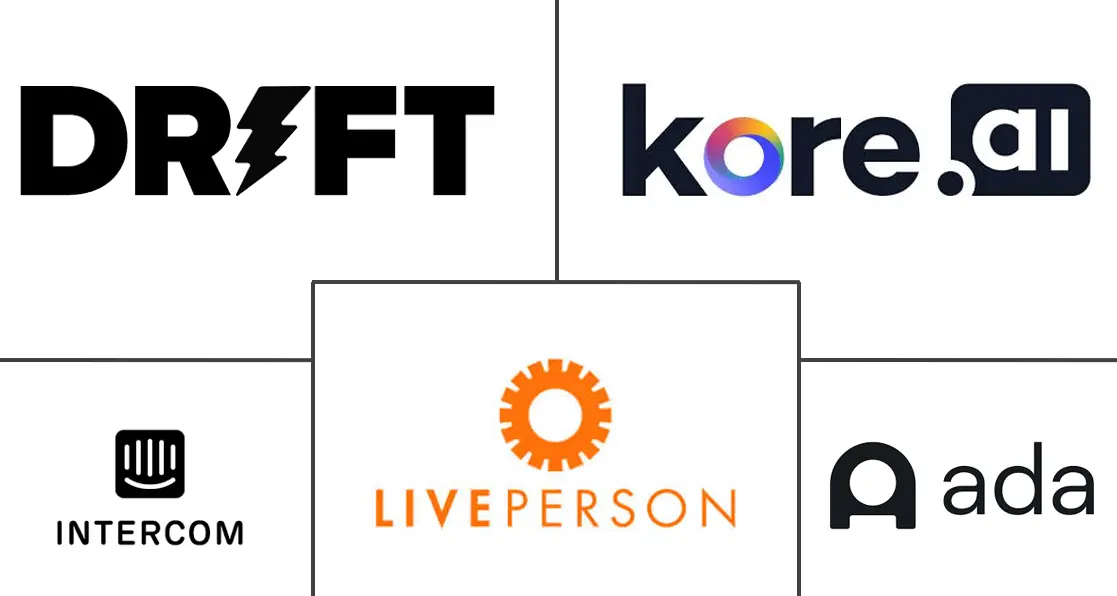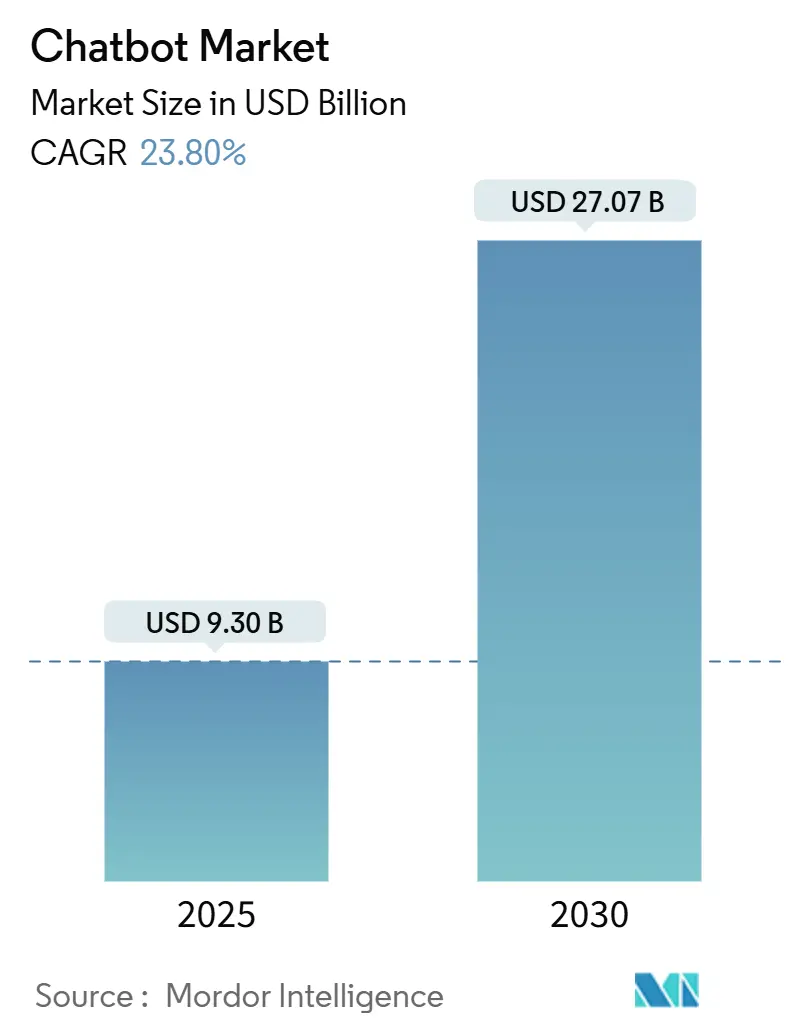
Chatbot Market Analysis by Mordor Intelligence
The Chatbot market size stands at USD 9.30 billion in 2025 and is projected to rise to USD 27.07 billion by 2030, reflecting a 23.8% CAGR over the forecast period. This sustained expansion is propelled by ubiquitous messaging-app reach, rapid advances in large-language-model performance, and mounting cost pressures on traditional contact-center operations. Customer experience leaders now prioritize autonomous, always-on channels that lower service costs while sustaining human-like interactions across voice, text, and multimodal interfaces. Platform vendors respond by embedding retrieval-augmented generation, multilingual models, and fine-tuned domain agents that reduce development cycles and democratize deployment. As enterprises seek measurable ROI, vendors emphasize outcome-linked pricing, proactive compliance tooling, and verticalized knowledge packs that accelerate time-to-value in regulated industries. Competitive intensity is rising as global hyperscalers, independent specialists, and CX outsourcers consolidate capabilities through acquisitions, partnerships, and strategic capital infusions.
Key Report Takeaways
- By component, platform, and software, captured 64.7% revenue share of the Chatbot market in 2024; services are projected to expand at a 24.8% CAGR through 2030.
- By application, customer support accounted for 42.4% of the Chatbot market size in 2024, while HR and recruiting are advancing at a 25.3% CAGR to 2030.
- By deployment mode, cloud maintained 78.4% share of the Chatbot market in 2024 and is forecast to grow at 24.7% CAGR through 2030.
- By organization size, large enterprises led with 68.2% of Chatbot market share in 2024; small and medium enterprises record the highest projected CAGR at 25.1% through 2030.
- By end-user industry, retail and eCommerce held 28.4% revenue share of the Chatbot market in 2024; healthcare is poised to register a 25.5% CAGR through 2030.
- By geography, North America commanded 39.16% of the Chatbot market size in 2024, while Asia-Pacific is expanding at a 25.4% CAGR to 2030.
Global Chatbot Market Trends and Insights
Drivers Impact Analysis
| Driver | (~) % Impact on CAGR Forecast | Geographic Relevance | Impact Timeline |
|---|---|---|---|
| Explosion of messaging-app user base | +4.2% | Global, with APAC leading adoption | Medium term (2-4 years) |
| Breakthroughs in large-language-model (LLM) NLP | +5.8% | North America and the EU core, expanding globally | Short term (≤ 2 years) |
| 24/7 customer-support cost pressure | +3.9% | Global, particularly in high-labor-cost regions | Short term (≤ 2 years) |
| Self-service mandates in digital CX strategies | +3.1% | North America and the EU, spreading to APAC | Medium term (2-4 years) |
| Voice-first and multimodal bot convergence | +2.7% | Global, with early adoption in North America | Long term (≥ 4 years) |
| LLM-powered internal knowledge automation | +3.3% | Enterprise-focused, primarily North America and the EU | Medium term (2-4 years) |
| Source: Mordor Intelligence | |||
Explosion of Messaging-App User Base
WhatsApp now serves 3 billion users and supports 175 million daily business conversations, giving the Chatbot market an immense, ready-made distribution channel. [1]Sinch Team, “Not Using Chatbots? Why Small Businesses Are Missing Out!,” Sinch, sinch.com Businesses have opened 764 million WhatsApp Business accounts that achieve 98% open rates versus 20% for email, dramatically lowering acquisition costs. The broader messaging ecosystem engages more than 200 million businesses worldwide, creating strong network effects that improve bot ROI across retail, banking, and healthcare. Firms leverage rich-media templates that shift interactions from marketing prompts to full-funnel transactions without requiring app downloads. As user familiarity rises, message-based journeys become the default interface for service queries, order tracking, and in-channel payments.
Breakthroughs in Large-Language-Model NLP
The launch of GPT-4.5 and expected GPT-5 models enabled chatbots to manage complex multi-turn dialogues with near-human fluency. [2]MKDev Editorial, “ChatGPT & EU AI Act: AI Literacy for Business,” MKDev, mkdev.me Enterprises such as Morgan Stanley showcased GPT-4 for internal knowledge retrieval, reducing advisor search time and boosting compliance confidence. Vendors embed retrieval-augmented generation so bots pull real-time data yet maintain conversation flow, addressing historical knowledge-cutoff limits. Yellow.ai orchestrates multi-LLM pipelines over 16 billion annual conversations, selecting specialized models per query to optimize cost and accuracy. These innovations cut training-data demands and open advanced conversational AI to SMEs lacking large labeled datasets.
24/7 Customer-Support Cost Pressure
AI chatbots deliver savings of USD 4.13 per interaction compared with human agents, driving 70% cost reductions for Vodafone and USD 150 million annual savings for Alibaba. Klarna’s AI agent now performs the workload of 700 humans, illustrating scalable economics. Beyond labor, organizations save on training, attrition, and shift-premium outlays while maintaining response times under 5 seconds. The cost gap widens as wages climb, compelling firms in retail, telecom, and travel to accelerate deployment of autonomous frontline agents.
Self-Service Mandates in Digital CX Strategies
Customer experience roadmaps now center on self-service, with 96% of shoppers believing firms should offer chatbots for support. Sixty-four percent of CX leaders plan to enhance bot capabilities by 2025 to satisfy digital-first preferences and reduce call volumes. Internal users mirror consumer expectations, pushing organizations to roll out knowledge bots for HR, IT, and finance help desks. High adoption correlates with higher Net Promoter Scores and lower abandonment rates, reinforcing investment momentum.
Restraints Impact Analysis
| Restraint | (~) % Impact on CAGR Forecast | Geographic Relevance | Impact Timeline |
|---|---|---|---|
| Integration complexity and legacy data silos | -2.8% | Global, particularly in established enterprises | Medium term (2-4 years) |
| Privacy/regulatory compliance concerns | -3.4% | EU and North America leading, global expansion | Short term (≤ 2 years) |
| Hallucination-driven brand-risk | -2.1% | Global, with higher impact in regulated industries | Short term (≤ 2 years) |
| Scarcity of vertical-grade training datasets | -1.9% | Global, with acute shortages in specialized domains | Long term (≥ 4 years) |
| Source: Mordor Intelligence | |||
Integration Complexity and Legacy Data Silos
Enterprises with decades-old systems face month-long timeline overruns when wiring chatbots into mainframes, CRMs, and ERPs. [3]BotsCrew Insights, “How Enterprise Chatbot Solutions & AI Are Shaping the Future of Big Businesses,” botscrew.com Forty-seven percent of firms build generative AI in-house to control data pipelines, reflecting integration anxiety. Middleware orchestration, real-time synchronization, and stringent security vetting inflate project budgets and delay full rollout, especially in banking and telecom, where data fragmentation is acute. As a result, greenfield digital-native firms gain time-to-market advantage, pressing incumbents to invest in API modernization.
Privacy/Regulatory Compliance Concerns
The EU AI Act, effective August 2024, mandates transparency notices, illegal-content safeguards, and human oversight, with fines up to EUR 35 million or 7% of global turnover for violations. Fortune 500 adoption of ChatGPT continues despite legal ambiguity, illustrating tension between innovation and risk. High-profile missteps, including Air Canada’s chatbot publishing erroneous fare policies and NYC municipal bots offering unlawful advice, spotlight brand exposure. Annual compliance outlays near EUR 29,277 per AI system, reshaping vendor selection criteria toward auditability and governance features.
Segment Analysis
By Component: Services Surge Despite Platform Dominance
Platform and software offerings retained a 64.7% share of the Chatbot market in 2024, underscoring their role as foundational infrastructure. Services, however, outpace overall growth at a 24.8% CAGR through 2030. Enterprises increasingly seek advisory, integration, and optimization expertise as conversational AI complexity rises. Yellow.ai packages full-lifecycle support covering strategy, custom model tuning, and ongoing governance, driving services demand. For clients, expert partners mitigate integration pain points and ensure compliance, turning vendor know-how into tangible business outcomes that justify premium fees.
Implementation consulting is often bundled with managed-service SLAs that guarantee uptime, retraining, and quarterly performance reviews. This shift nudges revenue mix toward recurring service contracts, smoothing vendor cash flows. As AI tooling matures, differentiation hinges less on base technology and more on outcome-driven engagement, favoring providers with deep vertical playbooks and robust partner ecosystems. The Chatbot market expects continued platform consolidation alongside a flourishing services layer that captures expanding wallet share.
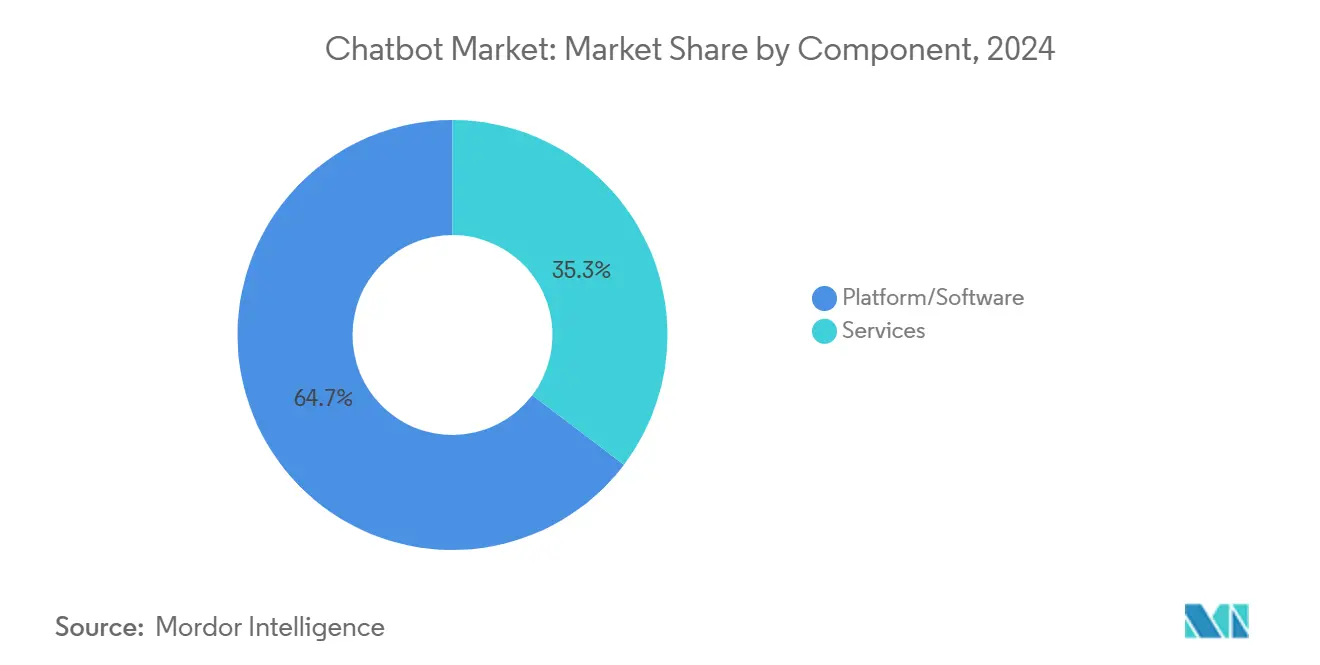
By Application: HR Automation Accelerates Beyond Customer Support
Customer support commanded 42.4% of the Chatbot market share in 2024, reflecting high ticket volumes and proven ROI. HR and recruiting use cases, however, register the quickest rise with a 25.3% CAGR through 2030. Bots prescreen candidates, schedule interviews, and answer policy questions, freeing HR teams for high-touch activities. Enterprises report 90% automation of repetitive inquiries and accelerated time-to-hire, translating into measurable productivity gains.
Sales and marketing bots nurture leads via personalized drip conversations, while IT service-desk agents reset passwords and diagnose hardware issues. Emerging internal knowledge assistants aggregate structured and unstructured content, cutting search cycles. This functional diversification underscores conversational AI’s versatility and cements its status as a core automation pillar rather than a niche support add-on.
By Deployment Mode: Cloud Dominance Reinforces Scalability Preferences
Cloud deployments accounted for 78.4% of the Chatbot market in 2024 and are expanding at a 24.7% CAGR. Elastic compute, pay-as-you-grow economics, and managed security updates resonate with firms scaling traffic peaks. Vendors strengthen data-residency guarantees and bring-your-own-key encryption to soothe sovereignty concerns. Enterprises facing stringent rules adopt hybrid designs that keep sensitive data on-premises while invoking cloud GPUs for inference. Nearly half of large enterprises still pursue on-premise builds to safeguard proprietary models, yet rising infrastructure expense curbs widespread uptake.
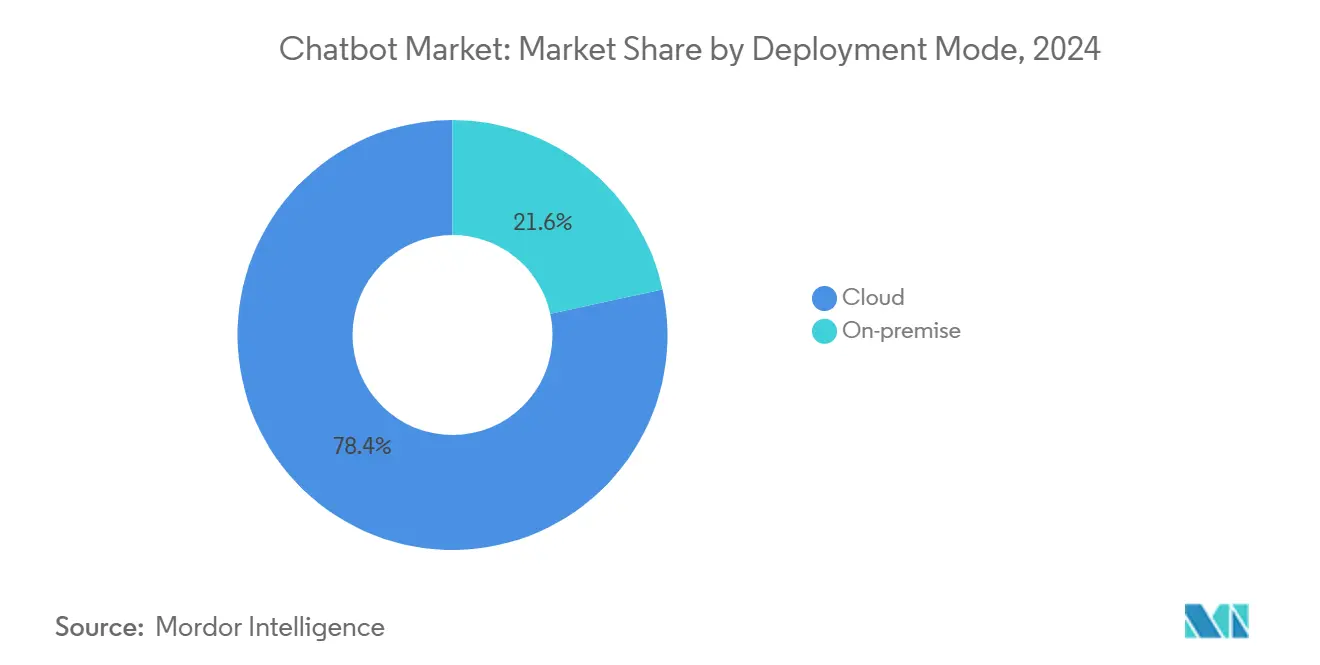
By Organization Size: SME Adoption Accelerates Market Democratization
Large enterprises held 68.2% of the Chatbot market share in 2024, leveraging budgets to deploy multi-channel, multilingual agents. Small and medium enterprises nevertheless drive the fastest expansion at 25.1% CAGR.
Low-code builders and subscription pricing remove technical and financial barriers, letting SMEs deploy bots in days. One study found SMEs trimmed average response times by 96% and lifted qualified-lead capture after rolling out chatbots. Regulatory clarity under the EU AI Act creates standardized guardrails that benefit resource-constrained firms, narrowing compliance gaps relative to larger peers.
By End-user Industry: Healthcare Surge Outpaces Retail Leadership
Retail and eCommerce maintained a 28.4% share of the Chatbot market revenue in 2024, propelled by order-tracking, product discovery, and promo-code bots. Healthcare, however, records a 25.5% CAGR as providers adopt 24/7 triage and scheduling assistants that alleviate staff shortages. MediBuddy achieved 90% satisfaction scores through automated symptom checks, while U.S. hospital chains use intake bots to streamline admissions.
BFSI continues steady uptake for balance inquiries and KYC tasks, and government agencies pilot citizen-service bots that cut queue times. Industry diversification demonstrates the technology’s widening acceptance across mission-critical workflows.
Geography Analysis
North America contributed 39.16% to the Chatbot market size in 2024, anchored by early LLM adoption and high labor costs that sharpen automation payback. U.S. financial institutions and retailers implement advanced voice-plus-vision agents, and Canadian enterprises tap GPT-4 for internal knowledge retrieval. Mature digital infrastructure and vibrant venture funding support continuous experimentation that spills over into Latin America through nearshore service hubs.
Asia-Pacific posts the fastest 25.4% CAGR through 2030 as governments back AI investments and mobile commerce proliferates. China poured USD 2.1 billion into AI projects, India’s chatbot segment grows 25% annually, and Singapore positions itself as an AI governance testbed. High smartphone penetration and super-app ecosystems generate massive conversational traffic, accelerating adoption in banking, travel, and public services. Local vendors tailor multilingual bots to regional dialects, fostering inclusive digital access.
Europe advances under the shadow of the EU AI Act, balancing innovation with rigorous compliance. Germany, France, and the U.K. integrate chatbots into manufacturing, healthcare, and public administration, with annual compliance budgets absorbed into total cost of ownership calculations. Standardized governance frameworks enhance cross-border collaborations and set de-facto global norms. Emerging regions, South America, the Middle East, and Africa benefit from falling cloud costs and expanding broadband, unlocking greenfield deployments across telecom, energy, and transport.
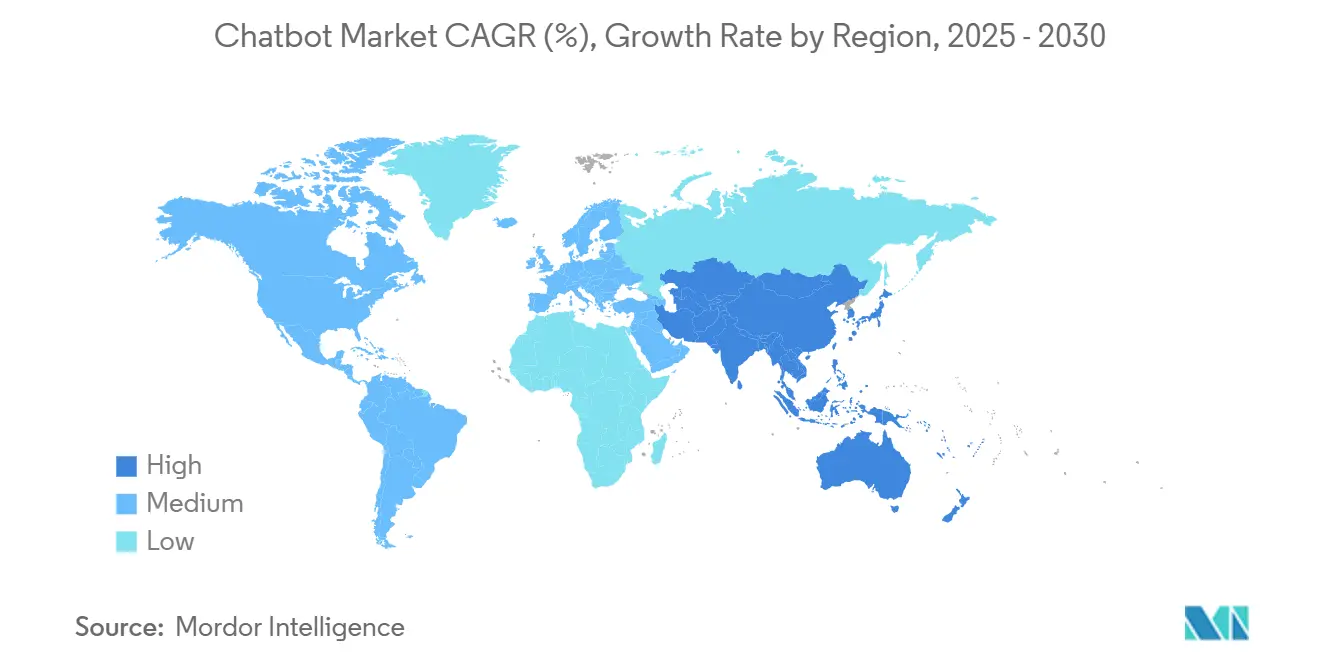
Competitive Landscape
The Chatbot market remains moderately fragmented yet shows rising concentration as incumbents and disruptors vie for scale. LivePerson leverages partnerships with Google Cloud and Avaya to deliver enterprise-grade engagement hubs, while Yellow.ai secures USD 75 million funding to refine its multi-LLM architecture. [4]LeadsOnTrees News Desk, “Yellow.ai Secures $75 Million in Funding to Revolutionize Customer Conversations Worldwide,” leadsontrees.com Kore.ai attracted USD 150 million with Nvidia backing to accelerate domain-specific autonomous agents. CX outsourcers embed proprietary bots into managed-service contracts, tightening platform-service synergies.
Competitive differentiation centers on model transparency, domain tuning, and integration breadth instead of baseline chatbot capability. Providers embed explainable AI dashboards and red-team testing to address hallucination risk and satisfy regulators. Strategic M&A targets include knowledge-base curation startups and low-code orchestration tools that shrink deployment timelines. Vendors courting regulated industries highlight certified data centers, role-based access, and audit trails. As revenue shifts from license to consumption-based metrics, durable advantage will favor platforms that combine extensible APIs, robust governance, and ecosystem marketplaces.
Chatbot Industry Leaders
-
LivePerson, Inc.
-
Kore.ai, Inc.
-
Ada Support Inc.
-
Intercom, Inc.
-
Drift.com, Inc.
- *Disclaimer: Major Players sorted in no particular order
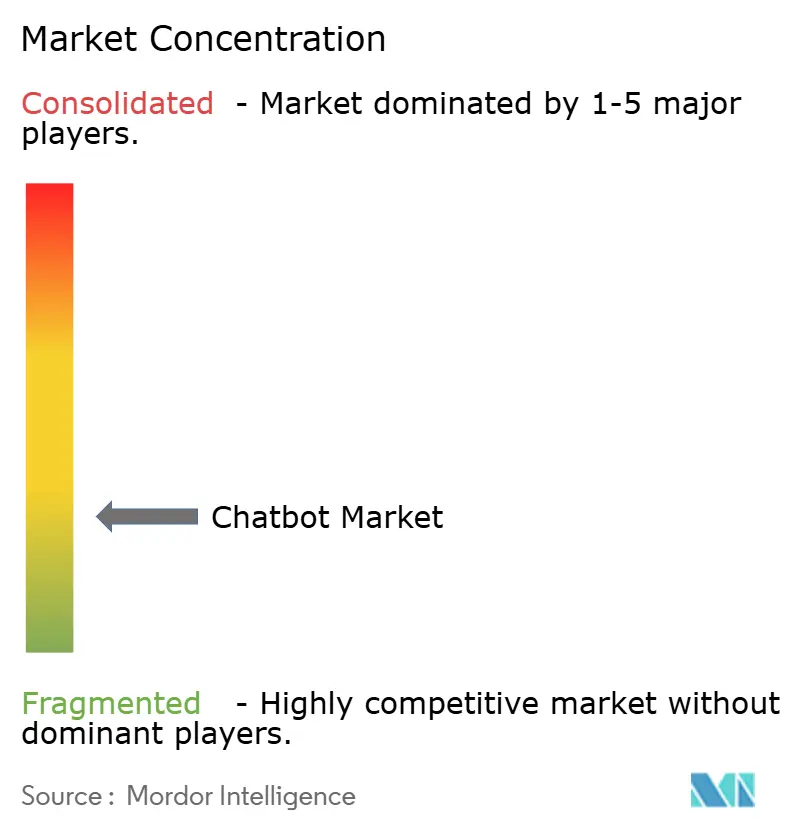
Recent Industry Developments
- March 2025: Deepgram published its State of Voice AI 2025 report, showing 97% corporate voice-tech adoption and 84% planned budget increases, signaling voice-chat convergence.
- February 2025: Major platforms rolled out multilingual upgrades supporting 50+ languages to meet global enterprise localization needs.
- January 2025: Enterprises completed hybrid cloud-on-premise chatbot rollouts that balance latency and sovereignty demands.
- December 2024: Yellow.ai raised USD 75 million to scale generative AI customer-service automation across new geographies.
Global Chatbot Market Report Scope
The chatbot market is defined based on the revenues generated by solutions sold by various global market players. The analysis is based on the market insights captured through secondary research and primary. The market also covers the major factors impacting the market's growth in terms of drivers and restraints.
The chatbot market is segmented by end-user vertical (BFSI, healthcare, IT and telecommunication, retail, and travel and hospitality) and geography (North America, Europe, Asia Pacific, Latin America, and Middle East and Africa). The Report Offers Market Forecasts and Size in Value (USD) for all the Above Segments.
| Platform/Software |
| Services |
| Customer Support |
| Sales and Marketing |
| HR and Recruiting |
| IT Service Management |
| Others |
| Cloud |
| On-premise |
| Small and Medium Enterprises (SMEs) |
| Large Enterprises |
| Retail and eCommerce |
| BFSI |
| Healthcare |
| Travel and Hospitality |
| Telecom and IT |
| Government and Public Sector |
| Other End-user Industries |
| North America | United States | |
| Canada | ||
| Mexico | ||
| South America | Brazil | |
| Argentina | ||
| Chile | ||
| Rest of South America | ||
| Europe | Germany | |
| United Kingdom | ||
| France | ||
| Italy | ||
| Spain | ||
| Rest of Europe | ||
| Asia-Pacific | China | |
| India | ||
| Japan | ||
| South Korea | ||
| Malaysia | ||
| Singapore | ||
| Australia | ||
| Rest of Asia-Pacific | ||
| Middle East and Africa | Middle East | United Arab Emirates |
| Saudi Arabia | ||
| Turkey | ||
| Rest of Middle East | ||
| Africa | South Africa | |
| Nigeria | ||
| Rest of Africa | ||
| By Component | Platform/Software | ||
| Services | |||
| By Application | Customer Support | ||
| Sales and Marketing | |||
| HR and Recruiting | |||
| IT Service Management | |||
| Others | |||
| By Deployment Mode | Cloud | ||
| On-premise | |||
| By Organization Size | Small and Medium Enterprises (SMEs) | ||
| Large Enterprises | |||
| By End-user Industry | Retail and eCommerce | ||
| BFSI | |||
| Healthcare | |||
| Travel and Hospitality | |||
| Telecom and IT | |||
| Government and Public Sector | |||
| Other End-user Industries | |||
| By Geography | North America | United States | |
| Canada | |||
| Mexico | |||
| South America | Brazil | ||
| Argentina | |||
| Chile | |||
| Rest of South America | |||
| Europe | Germany | ||
| United Kingdom | |||
| France | |||
| Italy | |||
| Spain | |||
| Rest of Europe | |||
| Asia-Pacific | China | ||
| India | |||
| Japan | |||
| South Korea | |||
| Malaysia | |||
| Singapore | |||
| Australia | |||
| Rest of Asia-Pacific | |||
| Middle East and Africa | Middle East | United Arab Emirates | |
| Saudi Arabia | |||
| Turkey | |||
| Rest of Middle East | |||
| Africa | South Africa | ||
| Nigeria | |||
| Rest of Africa | |||
Key Questions Answered in the Report
How fast is the Chatbot market projected to grow to 2030?
Revenue is forecast to rise from USD 9.30 billion in 2025 to USD 27.07 billion by 2030, reflecting a 23.8% CAGR.
Which region offers the quickest growth opportunity?
Asia-Pacific leads with a projected 25.4% CAGR, fueled by large user bases, mobile commerce adoption, and government AI programs.
Where do enterprises see the greatest cost savings?
Customer support automation delivers up to 92% cost reduction, saving USD 4.13 per interaction compared with human agents.
What deployment model do most organizations prefer?
Cloud deployments hold 78.4% share thanks to elastic scaling and managed security, though hybrid models are gaining in regulated sectors.
Which application is growing fastest beyond customer service?
HR and recruiting chatbots are expanding at 25.3% CAGR as firms automate candidate screening, onboarding, and policy inquiries.
How does regulation impact European adoption?
The EU AI Act imposes transparency and safety mandates; annual compliance costs near EUR 29,277 per AI system but also provide standardized governance that encourages responsible scaling.
Page last updated on:
